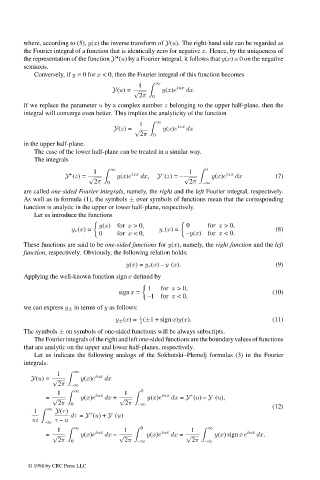Page 516 - Handbook Of Integral Equations
P. 516
where, according to (5), y(x) the inverse transform of Y(u). The right-hand side can be regarded as
the Fourier integral of a function that is identically zero for negative x. Hence, by the uniqueness of
+
the representation of the function Y (u) by a Fourier integral, it follows that y(x) ≡ 0 on the negative
semiaxis.
Conversely, if y ≡ 0 for x < 0, then the Fourier integral of this function becomes
∞
1 iux
Y(u)= √ y(x)e dx.
2π 0
If we replace the parameter u by a complex number z belonging to the upper half-plane, then the
integral will converge even better. This implies the analyticity of the function
1 ∞ izx
Y(z)= √ y(x)e dx
2π 0
in the upper half-plane.
The case of the lower half-plane can be treated in a similar way.
The integrals
0
1 ∞ 1
+ izx – izx
Y (z)= √ y(x)e dx, Y (z)= – √ y(x)e dx (7)
2π 0 2π –∞
are called one-sided Fourier integrals, namely, the right and the left Fourier integral, respectively.
As well as in formula (1), the symbols ± over symbols of functions mean that the corresponding
function is analytic in the upper or lower half-plane, respectively.
Let us introduce the functions
y(x) for x >0, 0 for x >0,
y + (x)= y – (x)= (8)
0 for x <0, –y(x) for x <0.
These functions are said to be one-sided functions for y(x), namely, the right function and the left
function, respectively. Obviously, the following relation holds:
y(x)= y + (x) – y – (x). (9)
Applying the well-known function sign x defined by
1 for x >0,
sign x = (10)
–1 for x <0,
we can express y ± in terms of y as follows:
1
y ± (x)= (±1 + sign x)y(x). (11)
2
The symbols ± on symbols of one-sided functions will be always subscripts.
The Fourier integrals of the right and left one-sided functions are the boundary values of functions
that are analytic on the upper and lower half-planes, respectively.
Let us indicate the following analogs of the Sokhotski–Plemelj formulas (3) in the Fourier
integrals:
1 ∞ iux
Y(u)= √ y(x)e dx
2π –∞
0
1 ∞ iux 1 iux + –
= √ y(x)e dx + √ y(x)e dx = Y (u) – Y (u),
2π 0 2π –∞
∞ (12)
1 Y(τ) + –
dτ = Y (u)+ Y (u)
πi τ – u
–∞
∞ 0 ∞
1 iux 1 iux 1 iux
= √ y(x)e dx – √ y(x)e dx = √ y(x) sign xe dx.
2π 0 2π –∞ 2π –∞
© 1998 by CRC Press LLC
© 1998 by CRC Press LLC
Page 498

